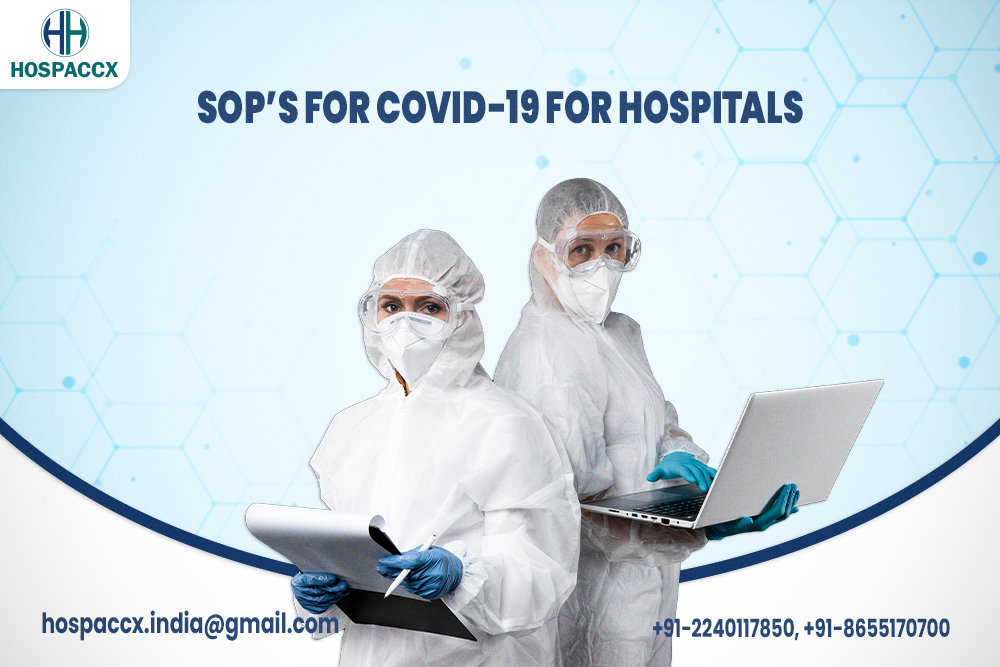INTRODUCTION:
Are you planning to build or restructure or venture in any healthcare venture in India ? Looking for information about the major healthcare players in government, private diagnostic centers that are available in India? Are you looking to find out which part of the of the city’s is best to venture in or what all facilities are available and what all should be planned for new setup? In this article Hospaccx Healthcare Consultancy has mentioned SOP’s for COVID-19 isolation wards for Hospitals. Below are the SOP’s that have to followed by Hospitals for treating COVID-19 Patients. If you need any further assistance in designing Isolation Wards for COVID -19 patients, or a refined market and financial feasibility or any other study related to healthcare you can contact Hospaccx Healthcare business
consulting Pvt. Ltd on hospaccx.india@gmail.com Or you can visit our website on
News about the new and deadly virus that appeared in Wuhan, China in December of 2019 is everywhere. The virus is now called severe acute respiratory syndrome coronavirus 2 (SARS-CoV-2) and the disease it causes is called COVID-19.
Why you need to know about this new virus:
The concern regarding this rapidly spreading virus is well-deserved. Unfortunately, the numbers are likely to rise as efforts to quickly contain its spread have proven unsuccessful. So, it’s particularly important to get reliable information about what is happening and to find out what you can do to
protect yourself.
Beware: Misinformation is rampant
Just as the number of people and countries affected by this new virus have spread, so have conspiracy theories and unfounded claims about it. Social media sites, including Facebook, Twitter, YouTube, and TikTok, have seen a number of false and misleading posts, such as:
- “Oregano Oil Proves Effective Against Coronavirus,” an unfounded claim
- A hoax stating that the US government had created and patented a vaccine for coronavirus years ago, shared with nearly 5,000 Facebook users
- A false claim that “coronavirus is a human-made virus in the laboratory”
- Sales of unproven “non-medical immune boosters” to help people ward off 2019-nCoV
- Unfounded recommendations to prevent infection by taking vitamin C and avoiding spicy foods
- Dangerous suggestions that drinking bleach and snorting cocaine can cure coronavirus infection
- A video with useless advice about preventing infection with the new coronavirus by modifying your diet (for example, by avoiding cold drinks, milkshakes, or ice cream).
To prevent infection and to slow transmission of COVID-19, do the following:
- Wash your hands regularly with soap and water, or clean them with alcohol- based hand rub.
- Maintain at least 1 metre distance between you and people coughing or sneezing.
- Avoid touching your face.
- Cover your mouth and nose when coughing or sneezing.
- Stay home if you feel unwell.
- Refrain from smoking and other activities that weaken the lungs.
- Practice physical distancing by avoiding unnecessary travel and staying away from large groups of people.
Quarantine and isolation
Quarantine and Isolation are important mainstay of cluster containment. These measures help by breaking the chain of transmission in the community.
- Quarantine: Quarantine refers to separation of individuals who are not yet ill but have been exposed to COVID-19 and therefore have a potential to become ill. There shall be voluntary home quarantine of contacts of suspect /confirmed cases.
- Isolation: Refers to separation of individuals who are ill and suspected or confirmed of COVID-19. All suspect cases detected in the containment/buffer zones (till a diagnosis is made), will be hospitalized and kept in isolation in a designated facility till such time they are tested negative.
- Persons testing positive for COVID-19 will remain to be hospitalized till such time 2 of their samples are tested negative as per discharge policy.
- About 15% of the patients are likely to develop pneumonia, 5 % of whom requires ventilator management.
- Hence dedicated Intensive care beds need to be identified earmarked. Some among them may progress to multi organ failure and hence critical care facility/ dialysis facility/ and Salvage therapy [Extra Corporeal Membrane Oxygenator (ECMO)] facility for managing the
respiratory/renal complications/ multi-organ failure shall be required. - If such facilities are not available in the containment zone, nearest tertiary care facility in Government / private sector needs to be identified, that becomes a part of the micro-plan.
- There are various modalities of isolating a patient. Ideally, patients can be isolated in individual isolation rooms or negative pressure rooms with 12 or more air-changes per hour.
- In resource constrained settings, all positive COVID-19 cases can be cohorts in a ward with good ventilation. Similarly, all suspect cases should also be cohorts in a separate 2ward.However under no circumstances these cases should be mixed up.
- A minimum distance of 1 meter needs to be maintained between adjacent beds. All such patients need to wear a triple layer surgical mask at all times.
- Nosocomial infection in fellow patients and attending healthcare personnel are well documented in the current COVID-19 outbreak as well.
- There shall be strict adherence to Infection prevention control practices in all health facilities.
- IPC committees would be formed (if not already in place) with the mandate to ensure that all healthcare personnel are well aware of IPC practices and suitable arrangements for requisite PPE and other logistic (hand sanitizer, soap, water etc.) are in place.
- The designated hospitals will ensure that all healthcare staff is trained in washing of hands, respiratory etiquettes, donning/doffing & proper disposal of PPEs and bio-medical waste management.
- At all times doctors, nurses and para-medics working in the clinical areas will wear three layered surgical mask and gloves. The medical personnel working in isolation and critical care facilities will wear full complement of PPE (including N95 masks).
- The support staff engaged in cleaning and disinfection will also wear full complement of PPE.
- Environmental cleaning should be done twice daily and consist of damp dusting and floor mopping with Lysol or other phenolic disinfectants and cleaning of surfaces with sodium hypochlorite solution. Setting up isolation facility/ward
- An isolation facility aims to control the airflow in the room so that the number of airborne infectious particles is reduced to a level that ensures cross-infection of other people within a healthcare facility is highly unlikely.
- At State level, a minimum of 50 bed isolation ward should be established.
- At District level, a minimum of 10 bed isolation ward should be established.
- Post signages on the door indicating that the space is an isolation area.
- Remove all non-essential furniture and ensure that the remaining furniture is easy to clean, and does not conceal or retain dirt or moisture within or around it.
- COVID-19 patients should be housed in single rooms. However, if sufficient single rooms are not available, beds could be put with a spatial separation of at least 1 meter (3 feet) from one another.
- To create a 10 bed facility, a minimum space of 2000 sq. feet area clearly segregated from other patient care areas is required.
- Preferably the isolation ward should have a separate entry/exit and should not be co-located with post-surgical wards/dialysis unit/SNCU/labour room etc.
- It should be in a segregated area which is not frequented by outsiders.
- The access to isolation ward should be through dedicated lift/guarded stairs.
- There should be double door entry with changing room and nursing station.
- Enough PPE should be available in the changing room with waste disposal bins to collect used PPEs.
- Used PPEs should be disposed as per the BMWM guidelines.
- Stock the PPE supply and linen outside the isolation room or area (e.g. in the change room).
- Setup a trolley outside the door to hold PPE.
- A checklist may be useful to ensure that all equipment is available.
- Place appropriate waste bags in a bin. If possible, use a touch-free bin. Ensure that used (i.e. dirty) bins remain inside the isolation rooms.
- Place a puncture-proof container for sharps disposal inside the isolation room/area and bio-medical waste should be managed as per the BMWM guidelines.
- Keep the patient’s personal belongings to a minimum. Keep water pitchers and cups, tissue wipes, and all items necessary for attending to personal hygiene within the patient’s reach.
- Non-critical patient-care equipment (e.g. stethoscope, thermometer, blood pressure cuff, and sphygmomanometer) should be dedicated for the patient, if possible.
- Any patient-care equipment that is required for use by other patients should be thoroughly cleaned and disinfected before use.
- Place an appropriate container with a lid outside the door for equipment that requires disinfection or sterilization.
- Ensure that appropriate hand washing facilities and hand-hygiene supplies are available.
- Stock the sink area with suitable supplies for hand washing, and with alcohol-based hand rub, near the point of care and the room door.
- Ensure adequate room ventilation.
- If room is air-conditioned, ensure 12 air changes/ hour and filtering of exhaust air.
- A negative pressure in isolation rooms is desirable for patients requiring aerosolization procedures (intubation, suction nebulisation).
- These rooms may have standalone air-conditioning. These areas should not be a part of the central air-conditioning.
- If air-conditioning is not available negative pressure could also be created through putting up 3-4 exhaust fans driving air out of the room.
- In district hospital, where there is sufficient space, natural ventilation may be followed.
- Such isolation facility should have large windows on opposite walls of the room allowing a natural unidirectional flow and air changes.
- The principle of natural ventilation is to allow and enhance the flow of outdoor air by natural forces such as wind and thermal buoyancy forces from one opening to another to achieve the desirable air change per hour.
- The isolation ward should have a separate toilet with proper cleaning and supplies.
- Avoid sharing of equipment, but if unavoidable, ensure that reusable equipment is appropriately disinfected between patients.
- Ensure regular cleaning and proper disinfection of common areas, and adequate hand hygiene by patients, visitors and care givers.
- Keep adequate equipment required for cleaning or disinfection inside the isolation room or area, and ensure scrupulous daily cleaning of the isolation room or area.
- Visitors to the isolation facility should be restricted /disallowed.
- For unavoidable entries, they should use PPE according to the hospital guidance, and should be instructed on its proper use and in hand hygiene practices prior to entry into the isolation room/area.
- Ensure that visitors consult the health-care worker in charge (who is also responsible for keeping a visitor record) before being allowed into the isolation areas.
- Keep a roster of all staff working in the isolation areas, for possible outbreak investigation and contact tracing.
- Doctors, nurses and paramedics posted to isolation facility need to be dedicated and not allowed to work in other patient-care areas.
- Consider having designated portable X-ray and portable ultrasound equipment.
- Corridors with frequent patient transport should be well-ventilated.
- All health staff involved in patient care should be well trained in the use of PPE.
- Set up a telephone or other method of communication in the isolation room or area to enable patients, family members or visitors to communicate with health-care workers.
- This may reduce the number of times the workers need to do PPE to enter the room or area
Checklist for isolation rooms
- Eye protection (visor or goggles)
- Face shield (provides eye, nose and mouth protection)
- Gloves
- Reusable vinyl or rubber gloves for environmental cleaning
- Latex single-use gloves for clinical care
- Hair covers
- Particulate respirators (N95, FFP2, or equivalent)
- Medical (surgical or procedure) masks
- Gowns and aprons
- Single-use long-sleeved fluid-resistant or reusable non-fluid-resistant gowns
- Plastic aprons (for use over non-fluid-resistant gowns if splashing is anticipated and if fluid-resistant gowns are not available)
- Alcohol-based hand rub
- Plain soap (liquid if possible, for washing hands in clean water)
- Clean single-use towels (e.g. paper towels)
- Sharps containers
- Appropriate detergent for environmental cleaning and disinfectant for disinfection of surfaces, instruments or equipment
- Large plastic bags
- Appropriate clinical waste bags
- Linen bags
- Collection container for used equipment
- Standard IEC
- Standard protocols for hand hygiene, sample collection and BMW displayed clearly
- Standard Clinical management protocols Wearing and removing Personal Protective Equipment (PPE)
Before entering the isolation room or area:
- Collect all equipment needed.
- Perform hand hygiene with an alcohol-based hand rub (preferably when hands are not visibly soiled) or soap and water.
- Put on PPE in the order that ensures adequate placement of PPE items and prevent self-contamination and self-inoculation while using and taking off PPE; an example of the order in which to don PPE when all PPE items are needed is hand hygiene, gown, mask or respirator, eye protection and gloves Leaving the isolation room or area:
- Either remove PPE in the anteroom or, if there is no anteroom, make sure that the PPE will not contaminate either the environment outside the isolation room or area, or other people.
- Remove PPE in a manner that prevents self-contamination or self- inoculation with contaminated PPE or hands.
- General principles are: – remove the most contaminated PPE items first; – perform hand hygiene immediately after removing gloves; – remove the mask or particulate respirator last (by grasping the ties and discarding in a rubbish bin); – discard disposable items in a closed rubbish bin; – put reusable items in a dry (e.g. without any disinfectant solution) closed container; an example of the order in which to take off PPE when all PPE items are needed is gloves (if the gown is disposable, gloves can be peeled off together with gown upon removal), hand hygiene, gown, eye protection, mask or respirator, and hand hygiene – Perform hand hygiene with an alcohol-based hand rub (preferably) or soap and water whenever un-gloved hands touch contaminated PPE items.
Transport of Infectious Patients:
- It is recommended that transport of infectious patients is limited to movement considered medically essential by the clinicians, e.g. for diagnostic or treatment purposes.
- Where infectious patients are required to be transported to other units within the hospital or outside the following precautions may be implemented:
- Infected or colonised areas of the patient’s body are covered: – For contact isolation this may include a gown, sheets or dressings to surface wounds; these patients are transferred to a Standard Pressure or Protective Environment Isolation room – For respiratory isolation the
patient is dressed in a mask, gown and covered in sheets; these patients are accommodated in a Negative Pressure Isolation Room – For quarantine isolation the patient may be transported in a fully enclosed transport cell or isolator with a filtered air supply and exhaust; these
patients are accommodated in a high level quarantine isolation suite. - The transport personnel remove existing PPE, cleanse hands and transport the patient on a wheelchair, bed or trolley, applying clean PPE to transport the patients and when handling the patient at the destination. Gown-up and gown-down rooms located at the entry to a Unit will assist the staff to enter and exit the facility according to the strict infection control protocols required, thereby reducing the risk of contamination.
- The destination unit should be contacted and notified prior to the transfer to ensure suitable accommodation on arrival.
- It is preferred that the patient is transported through staff and service corridors, not public access corridors During planning stages, design can assist transfer of infectious patients by providing service corridors and strategically placed lifts, capable of separation from other lifts. The nominated lift may be isolated from public and staff transit through access control measures and cleaned following transit of the infectious patient.
- Design may also incorporate a designated floor for horizontal bed transfers of infectious patients away from busy clinical areas. The designated floor may be located at mid-level in the hospital.
- A combination of nominated lifts, corridors and a bed transfer floor would assist in the movement of infectious patients through the hospital and minimise the risk of spread of infection.
Above are the SOP’s that have to followed by Hospitals for treating COVID- 19 Patients. If you need any further assistance in designing Isolation Wards for COVID -19 patients, or a refined market and financial feasibility or any other study related to healthcare you can contact Hospaccx Healthcare
business consulting Pvt. Ltd on hospaccx.india@gmail.com





Related Team Members
Related Services
Other Industries
Related Blog
Related Success Stories











